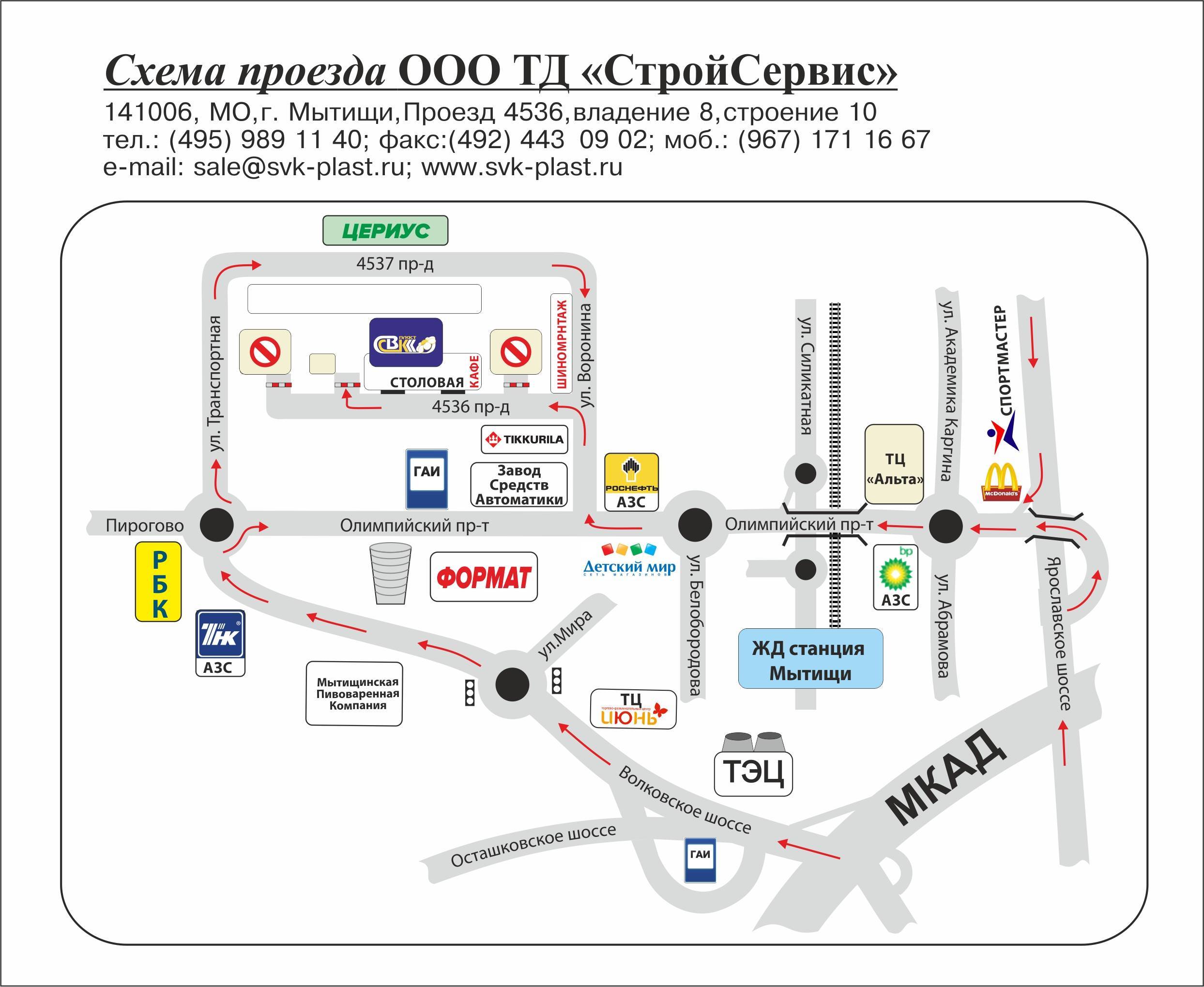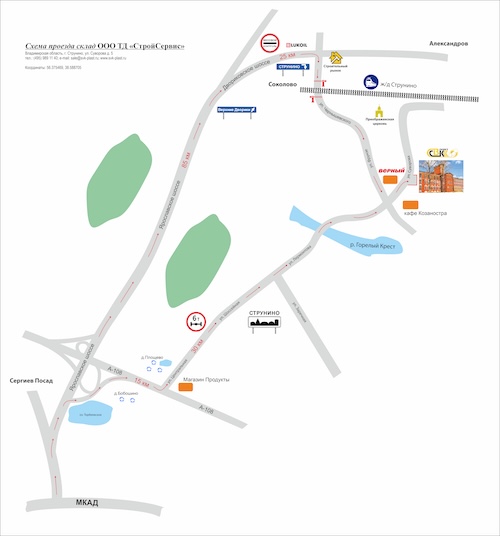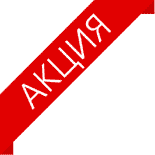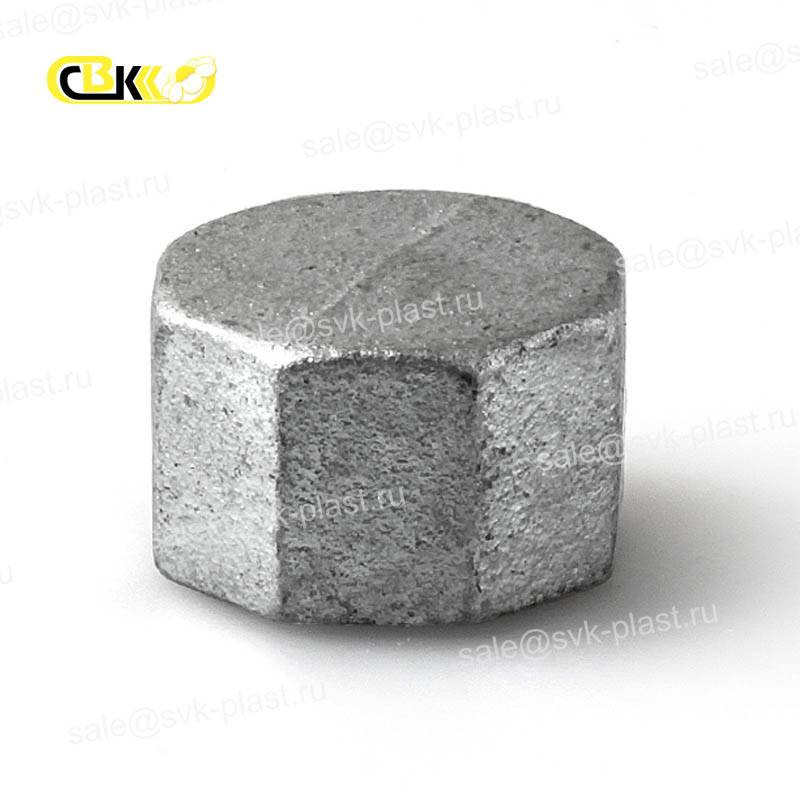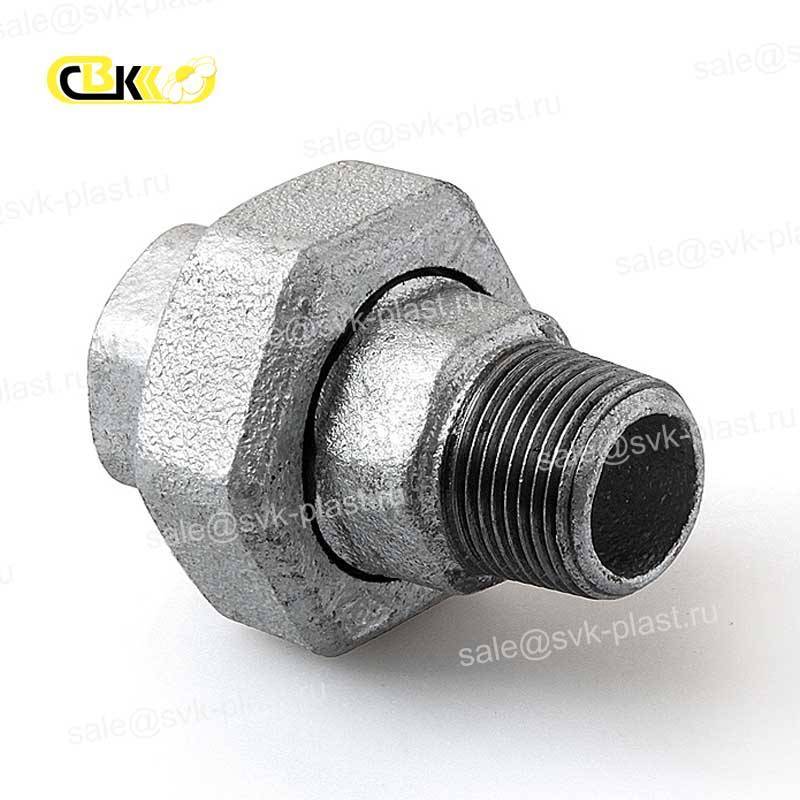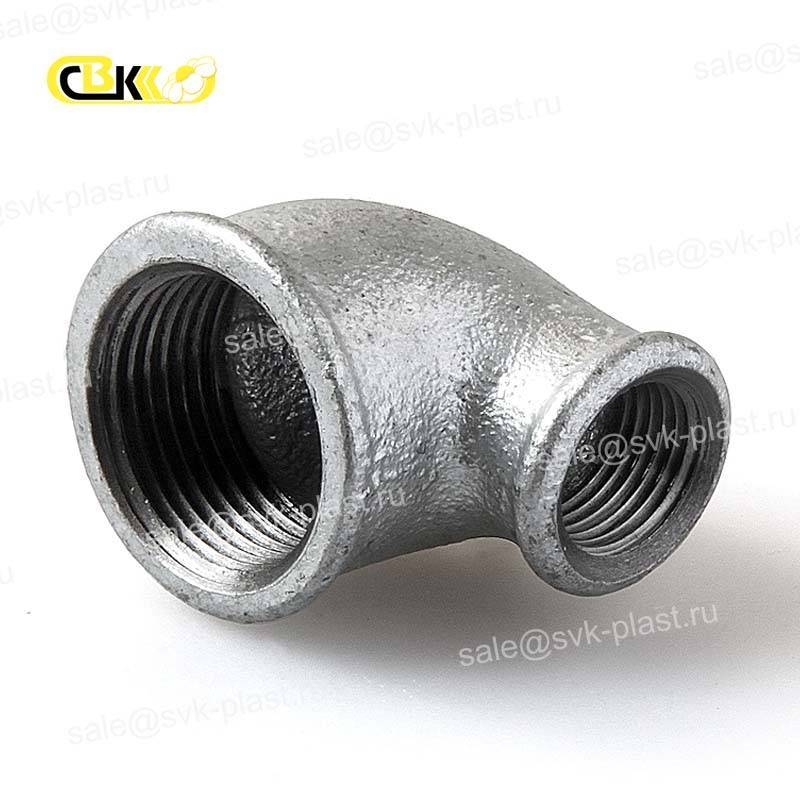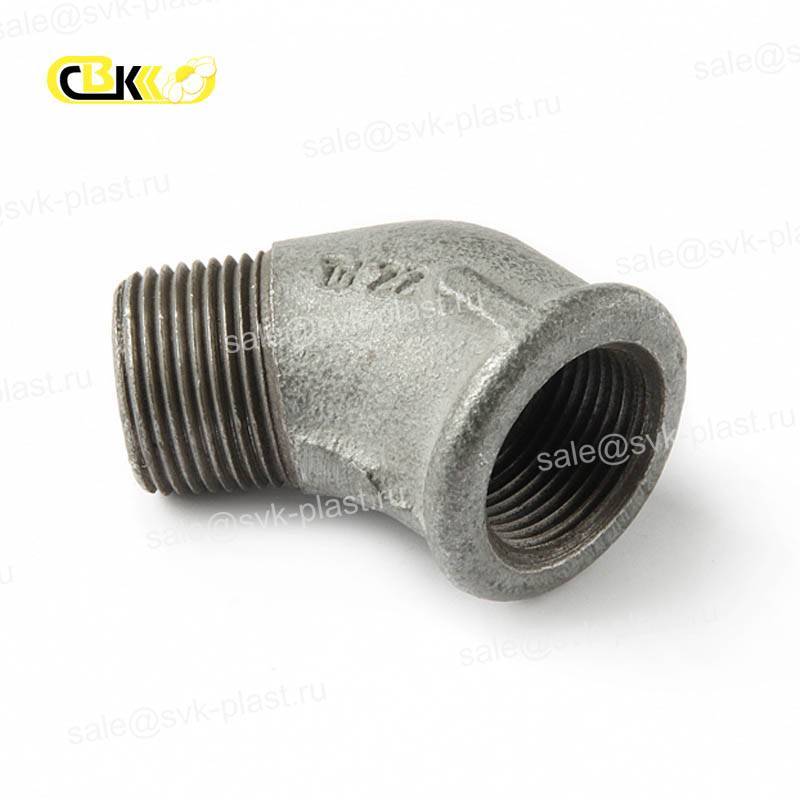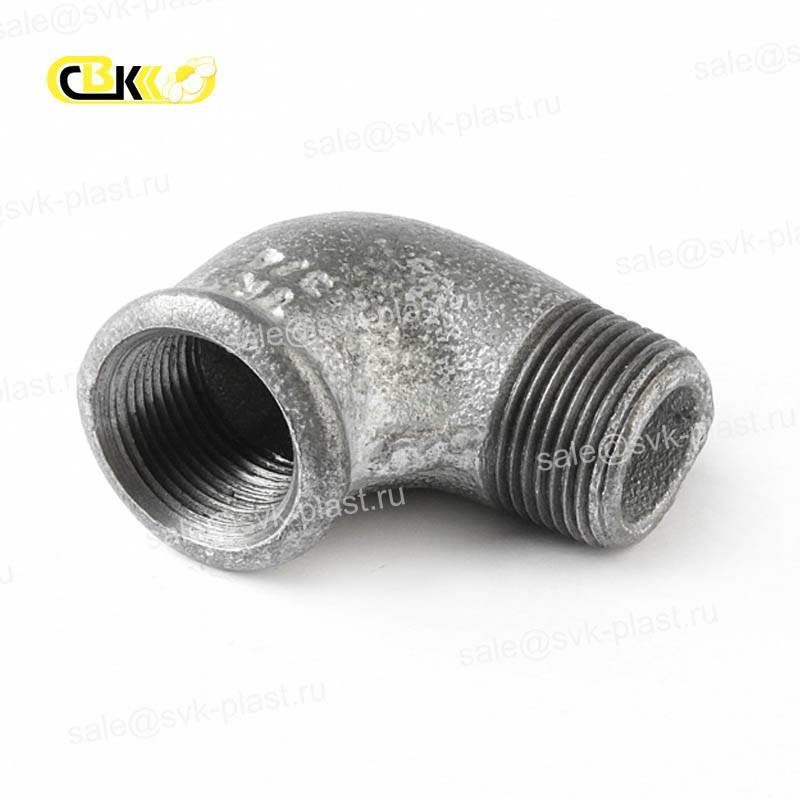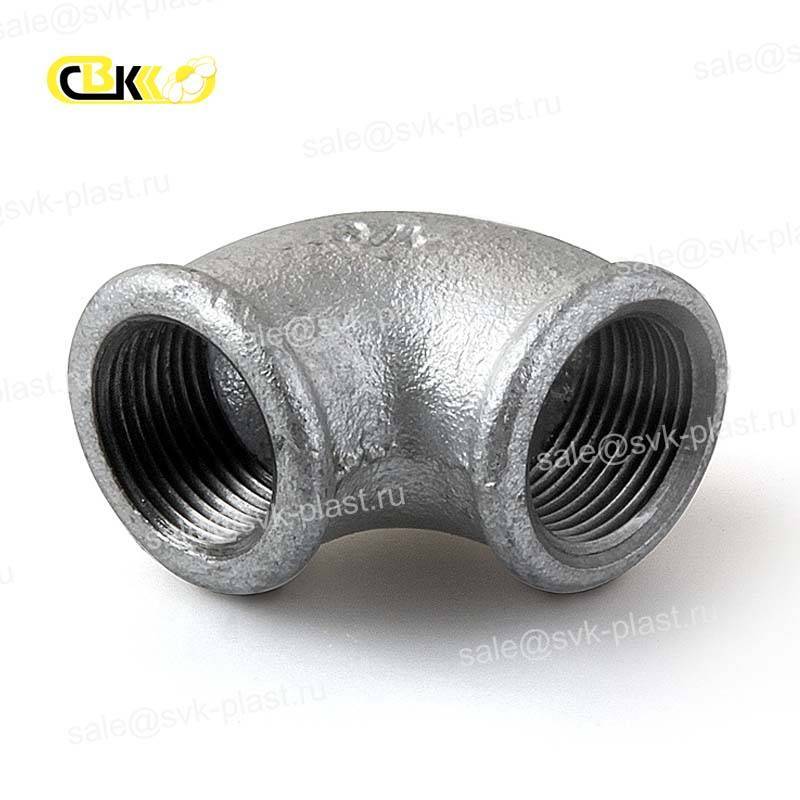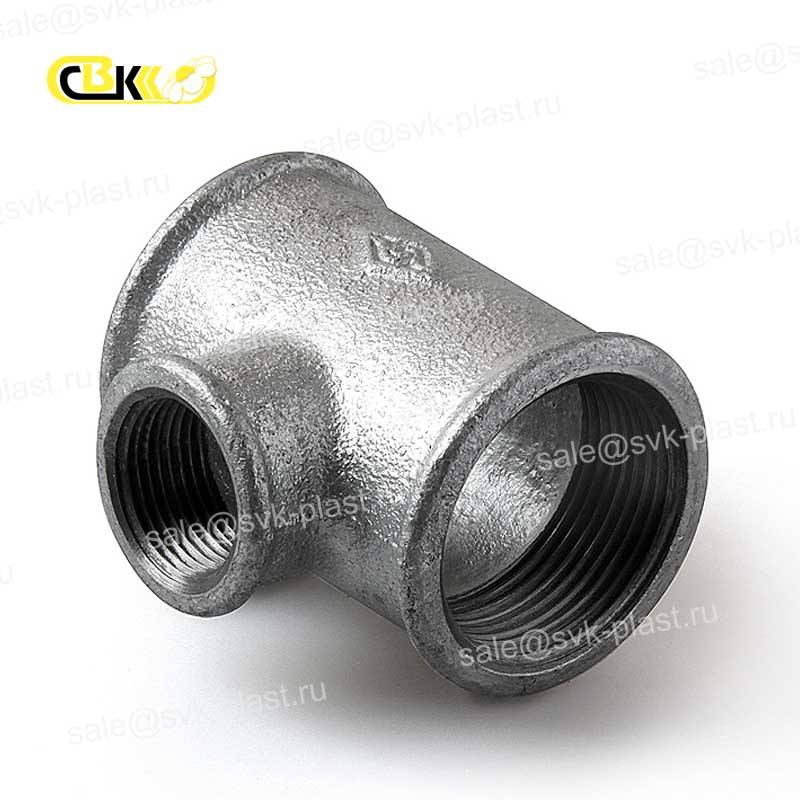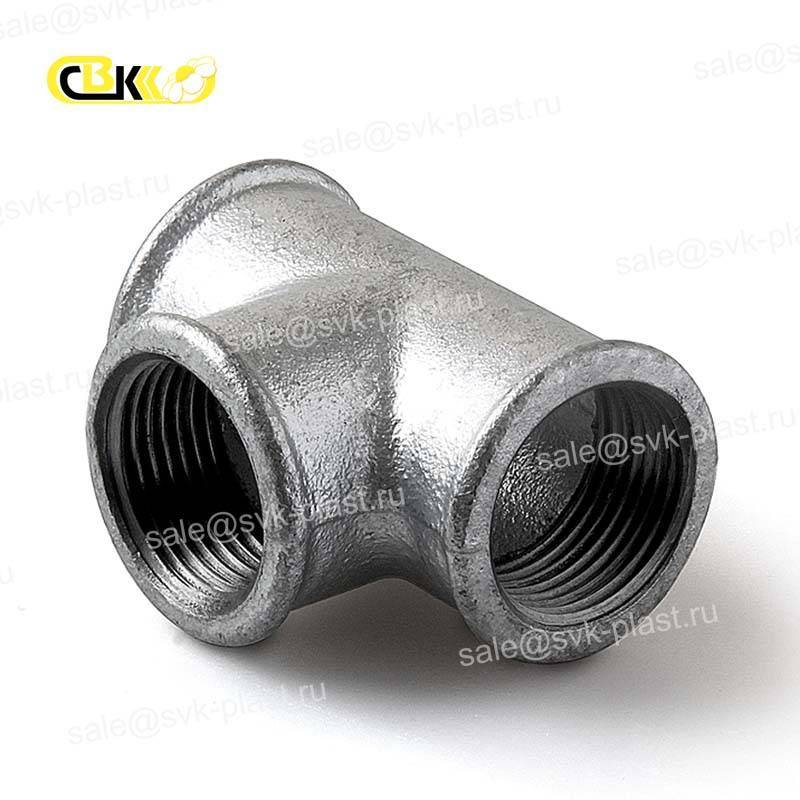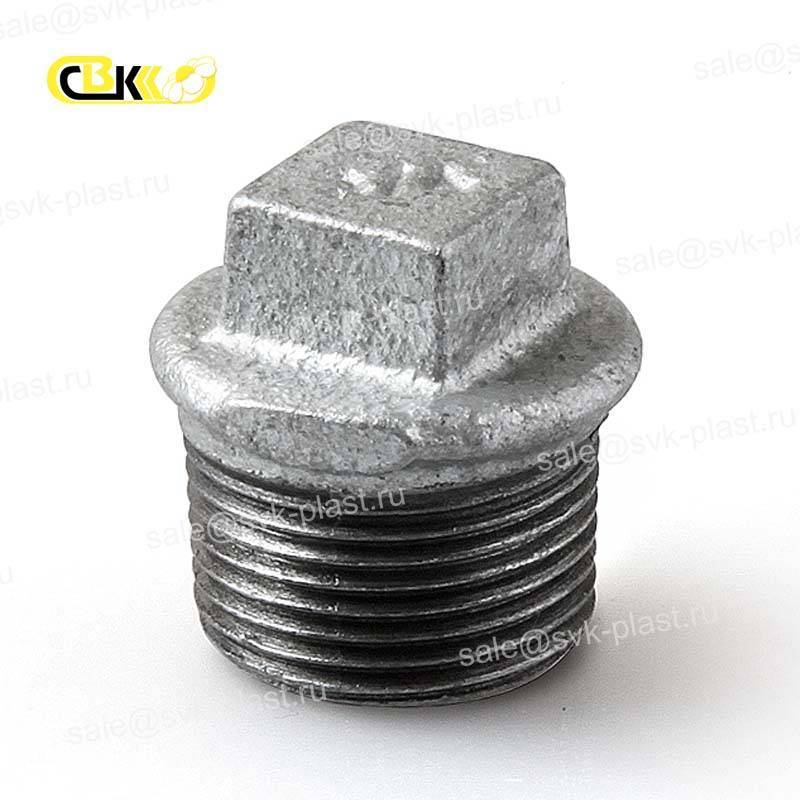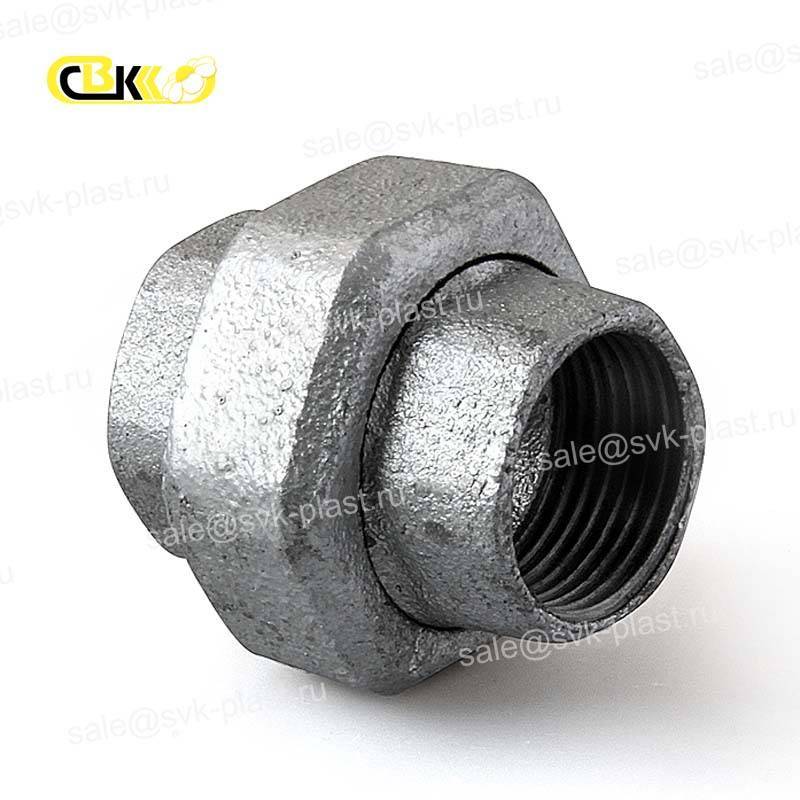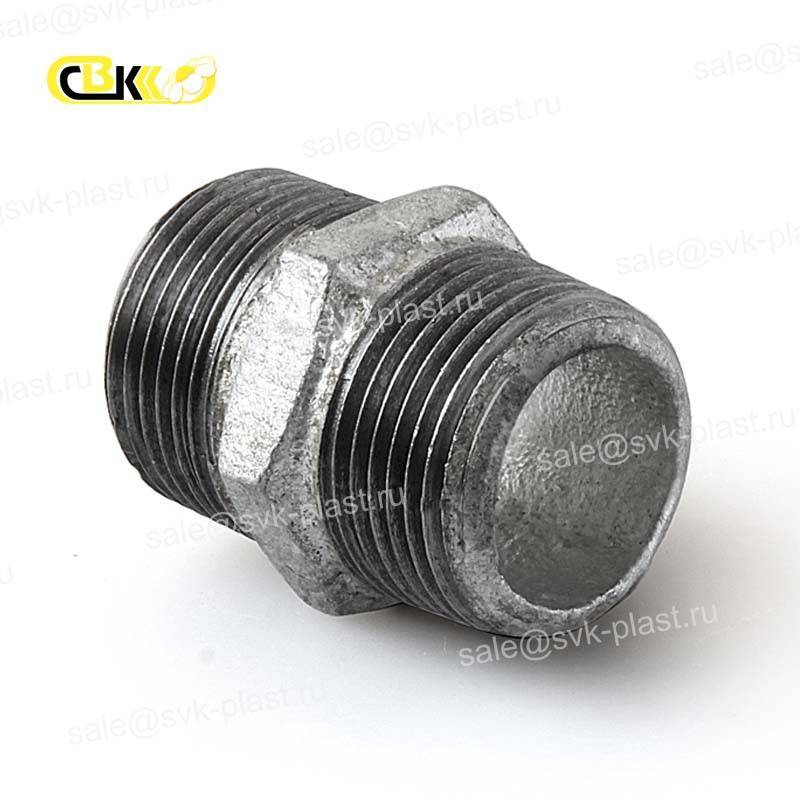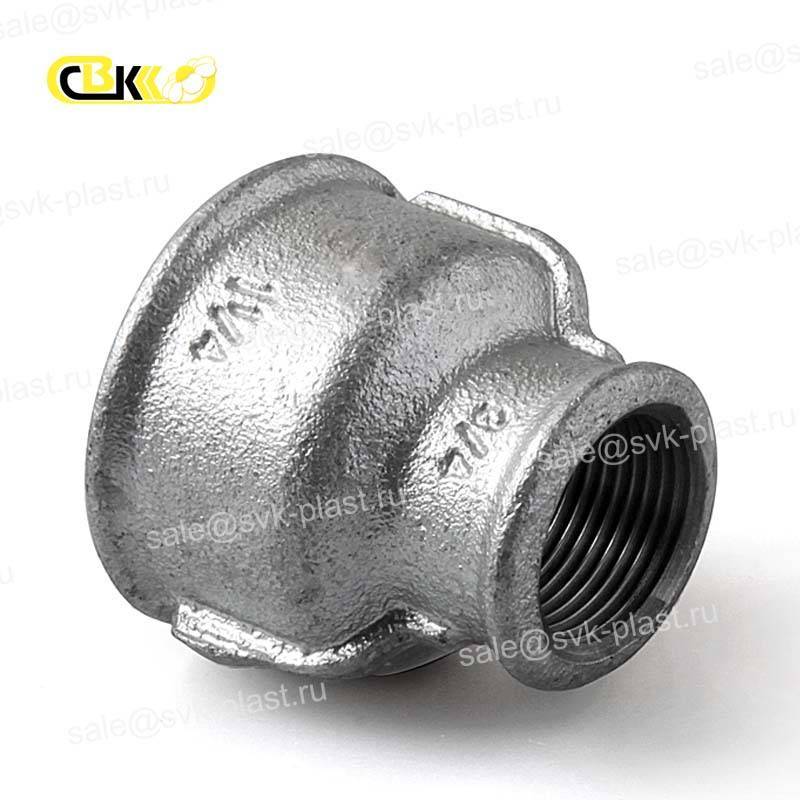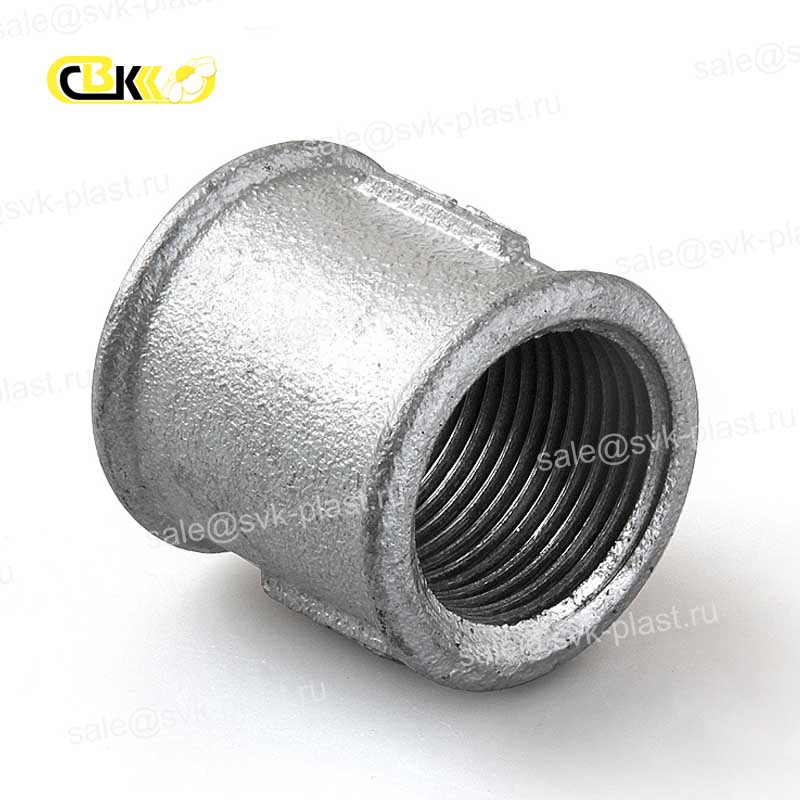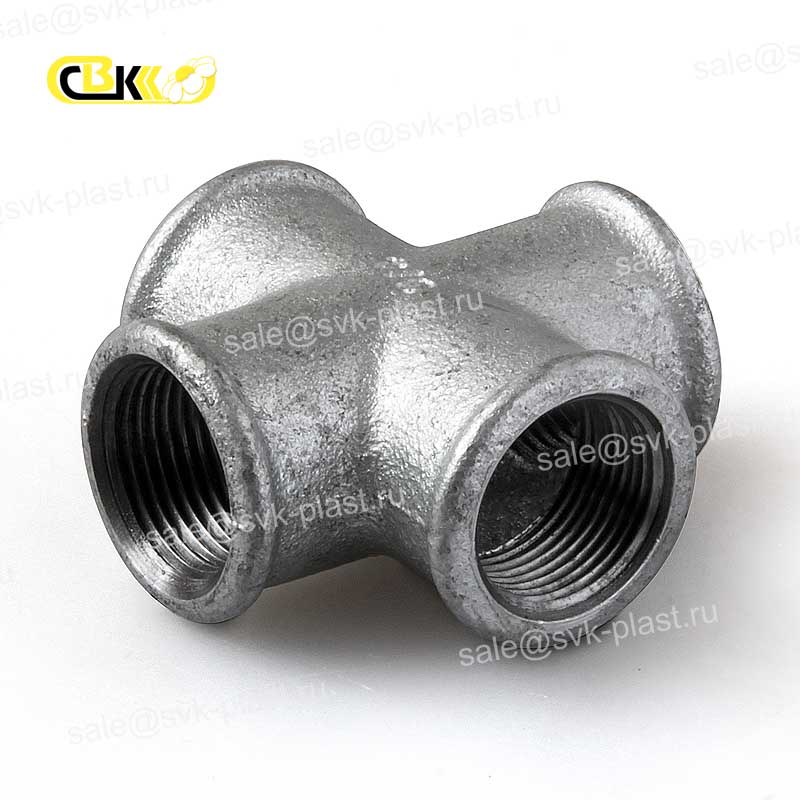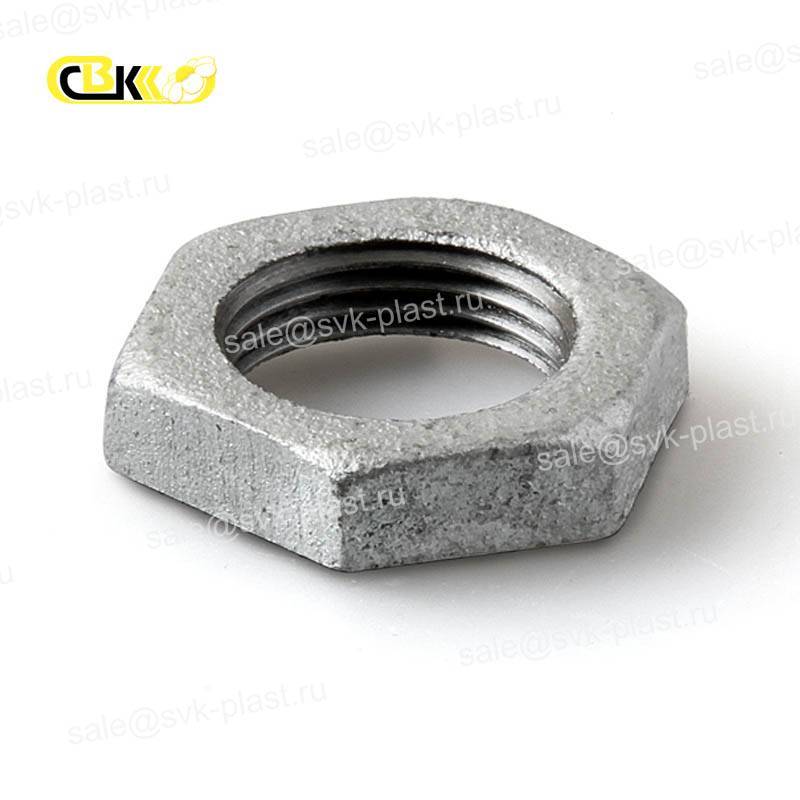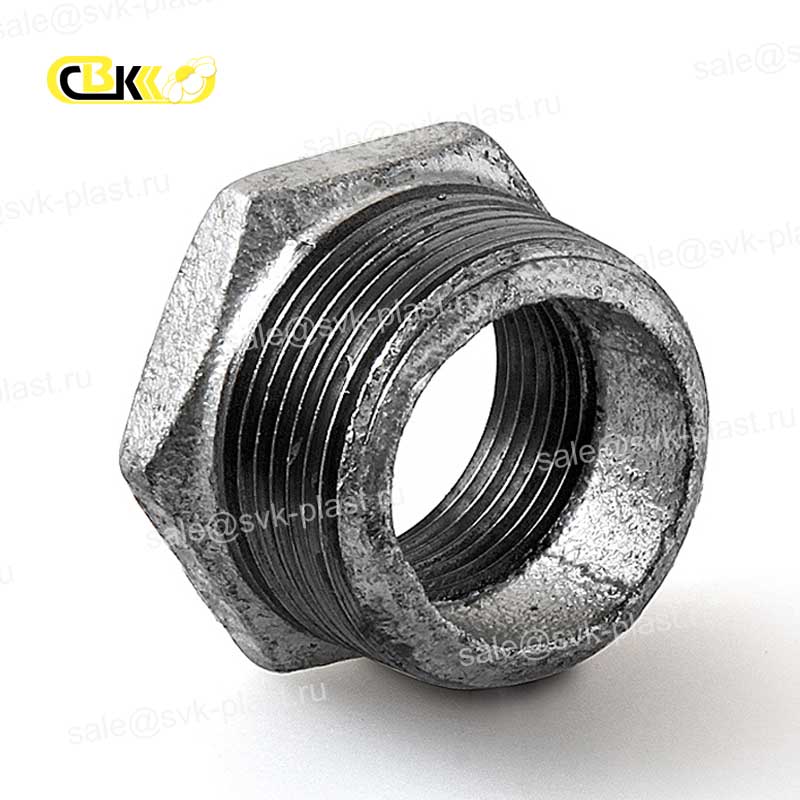Cast iron threaded galvanized fittings
BRENNEN cast iron fittings are reliable connecting elements for heating, water supply and gas distribution systems. The fitting body is made of ductile iron according to ISO 49 and EN10242 by injection molding. Two types are available without coating and with a zinc coating of at least 500 g / m2 or 70 microns. They are highly resistant to aggressive water solutions and transported gases. Galvanized fittings do not have restrictions on the operating environment and can be installed in wet rooms and outdoor pipelines. The internal threads of BRENNEN cast iron fittings are cylindrical, the external threads are conical with a taper of 1: 16. Threaded connections with a cylindrical external thread are used for seals through a gasket or locknut.
Cap cast iron galvanized BP
| Vendor code | Name |
|---|---|
| SVK-CIZF15z | BRENNEN BP Plug (digital) 1/2" |
| SVK-CIZF25z | BRENNEN BP Plug (digitized.) 1" |
| SVK-CIZF20z | BRENNEN BP Plug (digital) 3/4" |
| SVK-CIZF32z | BRENNEN BP Plug (digital) 1 1/4" |
| SVK-CIZF40z | BRENNEN BP Plug (digital) 1 1/2" |
| G30050 | BRENNEN BP Plug (digital) 2" |
The connection of the detachable cast-iron galvanized conical NR/BP
Square iron galvanized transition BP
Square iron galvanized NR/VR 45 degrees
| Vendor code | Name |
|---|---|
| 1012106 | BRENNEN Square 45 VR-NR (digitized) 1 " |
| 12115 | BRENNEN Square 45 VR-NR (digitized) 1/2" |
| 12120 | BRENNEN Square 45 VR-NR (digitized) 3/4" |
| 12132 | BRENNEN Square 45 VR-NR (digitized) 1 1/4" |
| 12140 | BRENNEN Square 45 VR-NR (digitized) 1 1/2" |
| 1012109 | BRENNEN Square 45 VR-NR (digitized) 2" |
Square iron galvanized NR / BP 90 degrees
Square iron galvanized BP 45 degrees
| Vendor code | Name |
|---|---|
| 12025 | BRENNEN Square 45 VR (digitized) 1" |
| 12032 | BRENNEN Angle of 45 BP (in.) 1 1/4 |
| 12015 | BRENNEN Square 45 BP (digitized) 1/2" |
| 12020 | BRENNEN Square 45 BP (digitized) 3/4" |
Square iron galvanized BP 90 degrees
| Vendor code | Name |
|---|---|
| SVK-CIEF40z | BRENNEN Corner 90 VR (digitized) 1 1/2" |
| 1009011 | BRENNEN Corner 90 VR (digitized) 3" |
| SVK-CIEF15z | BRENNEN Corner 90 VR (digitized) 1/2" |
| SVK-CIEF25z | BRENNEN Corner 90 VR (digitized) 1" |
| SVK-CIEF20z | BRENNEN Corner 90 VR (digitized) 3/4" |
| SVK-CIEF32z | BRENNEN Corner 90 VR (digitized) 1 1/4" |
| G9050 | BRENNEN Corner 90 VR (digitized) 2" |
| 1009010 | BRENNEN Corner 90 VR (digitized) 2 1/2" |
| 1009012 | BRENNEN Corner 90 VR (digitized) 4" |
T-piece cast iron galvanized BP transition
T-piece cast iron galvanized BP
| Vendor code | Name |
|---|---|
| SVK-CITF20z | BRENNEN Tee BP (digital) 3/4" |
| SVK-CITF15z | BRENNEN Tee BP (digital) 1/2" |
| SVK-CITF25z | BRENNEN Tee BP (digital) 1" |
| G130100 | BRENNEN Tee BP (digital) 4" |
| G13080 | BRENNEN Tee BP (digital) 3" |
| 1013009 | BRENNEN Tee BP (digital) 2" |
| SVK-CITF32z | BRENNEN Tee BP (digital) 1 1/4" |
| G13065 | BRENNEN Tee BP (digital) 2 1/2" |
| SVK-CITF40z | BRENNEN Tee BP (digital) 1 1/2" |
Split connection, cast iron, galvanized, straight NR / BP
| Vendor code | Name |
|---|---|
| SVK-CIAPFM25z | BRENNEN split straight Connection BP-HP (digital) 1" |
| G33150 | BRENNEN split straight Connection BP-HP (digital) 2" |
| SVK-CIAPFM15z | BRENNEN split straight Connection BP-HP (digital) 1/2" |
| SVK-CIAPFM40z | BRENNEN split straight Connection BP-HP (digital) 1 1/2" |
| SVK-CIAPFM32z | BRENNEN split straight Connection BP-HP (digital) 1 1/4" |
| SVK-CIAPFM20z | BRENNEN split straight Connection BP-HP (digital) 3/4" |
Cap, cast iron, galvanized HP
| Vendor code | Name |
|---|---|
| SVK-CIZM40z | BRENNEN plug HP (digital) 1 1/2" |
| SVK-CIZM25z | BRENNEN stub HP (digitized.) 1" |
| G29050 | BRENNEN stub HP (digital) 2" |
| SVK-CIZM15z | BRENNEN plug HP (digital) 1/2" |
| SVK-CIZM20z | BRENNEN plug HP (digital) 3/4" |
| SVK-CIZM32z | BRENNEN plug HP (digital) 1 1/4" |
Split joint, cast iron, galvanized, conical BP/BP
The connection of the detachable cast-iron galvanized direct BP/BP
| Vendor code | Name |
|---|---|
| G33050 | BRENNEN split straight Connection BP-BP (digital) 2" |
| SVK-CIAPF20z | BRENNEN split straight Connection BP-BP (digital) 3/4" |
| SVK-CIAPF32z | BRENNEN split straight Connection BP-BP (digital) 1 1/4" |
| G33065 | BRENNEN split straight Connection BP-BP (digital) 2 1/2" |
| SVK-CIAPF15z | BRENNEN split straight Connection BP-BP (digital) 1/2" |
| SVK-CIAPF40z | BRENNEN split straight Connection BP-BP (digital) 1 1/2" |
| SVK-CIAPF25z | BRENNEN split straight Connection BP-BP (digital) 1" |
The nipple is cast iron galvanized transition HP
NR galvanized iron nipple
| Vendor code | Name |
|---|---|
| SVK-CIMM20z | BRENNEN NR Nipple (digital) 3/4" |
| SVK-CIMM32z | BRENNEN Nipple male thread (in.) 1 1/4" |
| SVK-CIMM40z | BRENNEN Nipple male thread (in.) 1 1/2" |
| 1128010 | BRENNEN nipple NR (digital) 2 1/2" |
| SVK-CIMM15z | BRENNEN nipple HP (digital) 1/2" |
| BRENNEN NR Nipple (digital) 3" | |
| G28050 | BRENNEN nipple HP (digital) 2" |
| BRENNEN NR Nipple (digital) 4" | |
| SVK-CIMM25z | BRENNEN nipple HP (digital) 1" |
Coupling cast iron galvanized transition BP
| Vendor code | Name |
|---|---|
| G24040X15 | BRENNEN Coupling adapter BP (digital) 1 1/2"x1 / 2" |
| G24040X25 | BRENNEN Coupling adapter BP (digital) 1 1/2"x1" |
| SVK-CIMPF2520z | BRENNEN Coupling adapter BP (digital) 1"X3 / 4" |
| G24050X40 | BRENNEN Coupling adapter BP (digital) 2"x 1 1/2" |
| G24032X20 | BRENNEN Coupling adapter BP (digital) 1 1/4"X3 / 4" |
| SVK-CIMPF2515z | BRENNEN Coupling adapter BP (digital) 1"x1/2" |
| 1024022 | BRENNEN Coupling adapter BP (digital) 2"x 3/4" |
| G24040X32 | BRENNEN Coupling adapter BP (digital) 1 1/2"X11 / 4" |
| G24032X25 | BRENNEN Coupling adapter BP (digital) 1 1/4"x1" |
| G24050X25 | BRENNEN Coupling adapter BP (digital) 2"x1" |
| G24040X20 | BRENNEN Coupling adapter BP (digital) 1 1/2"X3 / 4" |
| G24032X15 | BRENNEN Coupling adapter BP (digital) 1 1/4"x1 / 2" |
| G24050X15 | BRENNEN Coupling adapter BP (digital) 2"x 1/2" |
| SVK-CIMPF2015z | BRENNEN Coupling adapter BP (digital) 3/4"x1 / 2" |
| G24050X32 | BRENNEN Coupling adapter BP (digital) 2"x 1 1/4" |
Coupling cast iron galvanized BP
| Vendor code | Name |
|---|---|
| SVK-CIMF32z | BRENNEN Coupling BP (digital) 1 1/4" |
| G27080 | BRENNEN Coupling BP (digital) 3" |
| G27065 | BRENNEN Coupling BP (digital) 2 1/2" |
| SVK-CIMF25z | BRENNEN Coupling BP (digital) 1" |
| SVK-CIMF15z | BRENNEN Coupling BP (digital) 1/2" |
| 1027012 | BRENNEN Coupling BP (digital) 4" |
| SVK-CIMF40z | BRENNEN Coupling BP (digital) 1 1/2" |
| SVK-CIMF20z | BRENNEN Coupling BP (digital) 3/4" |
| G27050 | BRENNEN Coupling BP (digital) 2" |
Crosspiece, cast iron, galvanized
| Vendor code | Name |
|---|---|
| G18015 | BRENNEN Crosspiece (digital) 1/2" |
| G18040 | BRENNEN Crosspiece (digital) 1 1/2" |
| G18020 | BRENNEN Crosspiece (digital) 3/4" |
| G18032 | BRENNEN Crosspiece (digital) 1 1/4" |
| G18025 | BRENNEN Crosspiece (digital) 1" |
| G18050 | BRENNEN Crosspiece (digital) 2 |
Lock nut, cast iron, galvanized
| Vendor code | Name |
|---|---|
| G31040 | BRENNEN locknut (digital) 1 1/2" |
| G31020 | BRENNEN locknut (digital) 3/4" |
| G31025 | BRENNEN locknut (digital).) 1" |
| G31050 | BRENNEN lock nut (galvanized) 2" |
| G31015 | BRENNEN locknut (digital) 1/2" |
| G31032 | BRENNEN locknut (digital) 1 1/4" |
Overlay threaded galvanized cast iron HP/BP
In addition to various types of shut-off and connecting fittings, when creating pipeline networks, various types of connecting elements are necessary, which include, first of all, fittings. Actually, the word "fitting" is English and means installation or Assembly. This factor explains the main purpose of these products.
The essence and structure of cast iron fittings
Cast iron fittings are connecting elements that connect gas pipes, as well as heat and water pipes. Compared to other materials, their main advantages are:
- Consistently high quality products.
- Ability to make the connection as tight as possible.
- Ease of installation.
- Acceptable cost.
- It can be used even after repeated dismantling.
The main element that provides the connection is the pipe thread. And to achieve maximum tightness, it is necessary to additionally use FUM tape, various types of paste or other analogues of seals. These types of seals were used many years ago. But until now, something better than such tools has not yet been invented.
Types of cast iron fittings
Classification of cast iron fittings today includes a fairly large number of product options. Each of them has a specific purpose, based on which there was a division into separate groups. In addition, a significant role in the classification is played by the type of reinforcement, which is also used for laying networks. The main types of cast iron fittings today are:
- Bends that allow you to change the direction of pipe placement.
- Tees (collectors) that allow you to create a branch of the pipeline into several networks.
- Crosspieces that allow the connection of four pipes.
- Straight couplings that allow you to connect two pipes located in the same direction.
- Adapters. Thanks to their use, you can connect structures of different diameters or made of different materials.
- Caps and caps that are necessary to cover the pipe.
- Fittings. Their purpose is to connect the pipe with a rubber hose.
One of the varieties of cast iron fittings are those that are coated with a special zinc coating. Due to this, their service life is much longer than that of conventional fittings.
Connection options for cast iron fittings
To ensure greater sealing, various types of seals must be used. Most often, their role is played by a FUM tape, which is wound on the pipe, after which the fitting is already screwed on. Wind the FUM tape only in a clockwise direction.
When using landfills, welding is used. Besides. installation of landfills requires appropriate experience.


